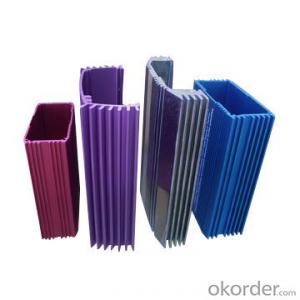aluminium profile manufacturer, 6060 6061 6063 6082 grade
- Loading Port:
- China Main Port
- Payment Terms:
- TT OR LC
- Min Order Qty:
- -
- Supply Capability:
- -
OKorder Service Pledge
Quality Product, Order Online Tracking, Timely Delivery
OKorder Financial Service
Credit Rating, Credit Services, Credit Purchasing
You Might Also Like
Material | Alloy 6063,6061,6005or according to customer’s choice |
Temper | T3, T4, T5, T6 |
Surface | Anodize, electrophoresis, powder coating, PVDF coating, wood grain painting, matted, etc. |
Color | Any colour based on Standard Germany RAL Mark |
Length | Coating 6.5 meters, Anodizing 6.5 meters, Mill finish 5 meters |
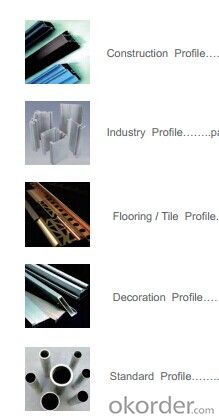

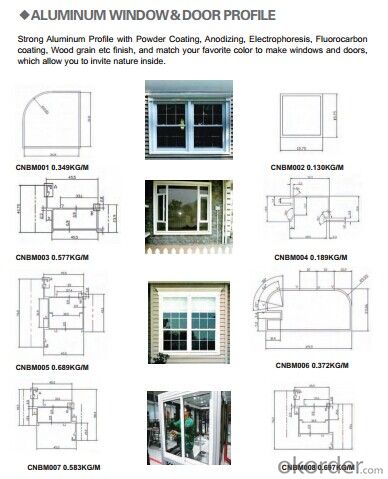
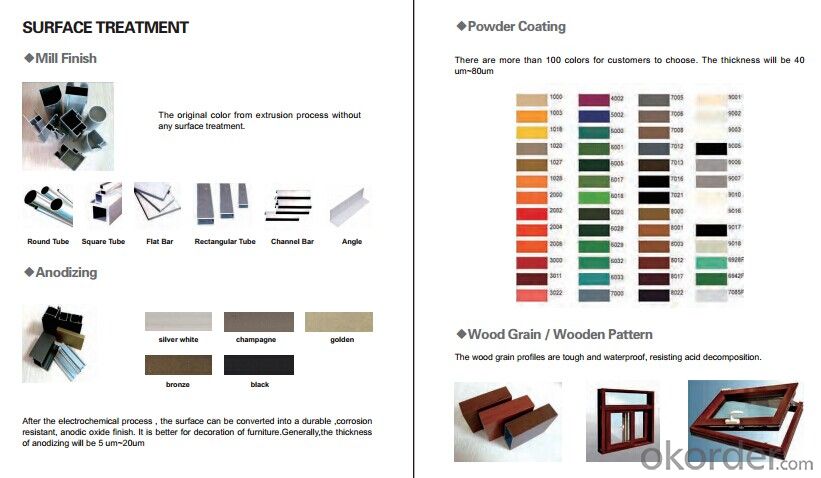
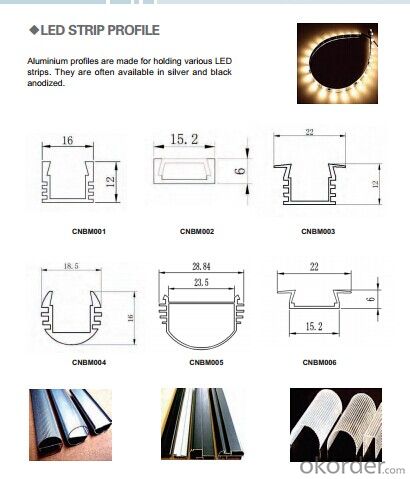
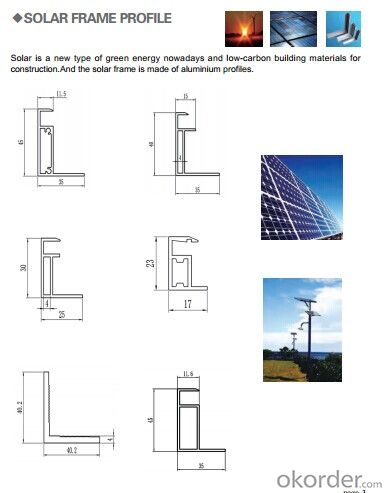
- Q:What are the different cutting methods for aluminum profiles?
- There are several cutting methods for aluminum profiles, including sawing, shearing, milling, and laser cutting. Sawing is commonly used for straight cuts and can be done manually or with a powered saw. Shearing involves using sharp blades to cut through the aluminum, typically for thin profiles. Milling involves using a rotating cutter to remove material and create complex shapes. Laser cutting uses a high-powered laser beam to melt or vaporize the aluminum, offering precise and clean cuts. The choice of cutting method depends on the desired shape, thickness, and accuracy required for the aluminum profiles.
- Q:How do aluminum profiles perform in terms of electrical conductivity?
- Aluminum profiles have relatively low electrical conductivity compared to other metals such as copper or silver, but they still conduct electricity to some extent. They can be used for applications where moderate conductivity is required, but for high-performance electrical applications, other metals may be more suitable.
- Q:How do aluminum profiles contribute to the reduction of carbon footprint?
- Due to their environmental benefits, aluminum profiles play a crucial role in reducing carbon footprints. To begin with, aluminum is a highly recyclable material, with nearly 75% of all aluminum ever produced still in use today. This recyclability greatly diminishes the necessity for extracting and refining new aluminum, which is an energy-intensive process that contributes to carbon emissions. Furthermore, the lightweight characteristic of aluminum profiles offers numerous advantages in terms of transportation and energy consumption. In comparison to materials like steel, aluminum is significantly lighter, resulting in reduced fuel consumption during transportation. This not only decreases carbon emissions but also lowers the overall energy required for logistics. Moreover, aluminum profiles are widely utilized in the construction industry, where they make a significant contribution to the energy efficiency of buildings. Aluminum's exceptional thermal conductivity allows for the creation of highly efficient windows, doors, and facades, which prevent heat transfer and reduce the need for excessive heating or cooling. By enhancing the energy efficiency of buildings, aluminum profiles aid in minimizing energy consumption and subsequently decreasing carbon emissions. Additionally, aluminum profiles have a long lifespan and require minimal maintenance, reducing the need for frequent replacement. This durability helps conserve resources and lowers the carbon emissions associated with the production and disposal of alternative materials. All in all, the utilization of aluminum profiles in various industries significantly contributes to the reduction of carbon footprints. Its recyclability, lightweight nature, energy efficiency, and durability all make aluminum a sustainable choice with a positive impact on the environment.
- Q:Are aluminum profiles suitable for use in the renewable energy industry?
- Yes, aluminum profiles are suitable for use in the renewable energy industry. Aluminum is lightweight, durable, and corrosion-resistant, making it ideal for applications such as solar panel frames, wind turbine components, and electrical infrastructure. It also offers excellent thermal conductivity and recyclability, aligning with the sustainability goals of the renewable energy sector.
- Q:What are the different surface finishing options available for aluminum profiles?
- There are several surface finishing options available for aluminum profiles, each offering different benefits and aesthetic appearances. Some of the commonly used surface finishing options for aluminum profiles include: 1. Anodizing: Anodizing is an electrochemical process that creates a protective oxide layer on the surface of the aluminum. This process not only enhances corrosion resistance but also provides a variety of color options. Anodized aluminum profiles are durable, easy to maintain, and have a smooth, attractive finish. 2. Powder Coating: Powder coating involves applying a dry powder to the surface of the aluminum profile and then curing it under heat. This process creates a tough, decorative finish that is resistant to chipping, scratching, and fading. Powder coating offers a wide range of color options and can be customized to achieve different textures and effects. 3. Polishing: Polishing is a mechanical process that creates a high-gloss, reflective finish on the aluminum profile. It involves using abrasives and polishing compounds to remove surface imperfections and achieve a smooth, mirror-like appearance. Polished aluminum profiles are commonly used in decorative applications where a sleek and shiny finish is desired. 4. Brushing: Brushing involves using abrasive brushes or pads to create a textured, brushed finish on the aluminum profile. This process produces parallel lines or circular patterns on the surface, giving it a unique and stylish appearance. Brushed aluminum profiles are often used in architectural and interior design applications. 5. Electrophoretic Coating: Electrophoretic coating, also known as e-coating, is an immersion process where an electrically charged paint is applied to the aluminum profile. This process ensures uniform coating thickness and excellent corrosion resistance. E-coating provides a smooth, even finish and is commonly used in automotive and industrial applications. 6. Wood Grain Effect: Aluminum profiles can be treated with a special coating to mimic the appearance of wood grain. This option is popular in architectural applications where the durability and low maintenance of aluminum are preferred over natural wood. These are just a few of the surface finishing options available for aluminum profiles. The choice of finishing method depends on the desired appearance, functionality, and intended application of the aluminum profile.
- Q:What are the different sizes and dimensions of aluminum profiles?
- The different sizes and dimensions of aluminum profiles can vary greatly depending on the specific application and manufacturer. They can range from small, narrow profiles with dimensions of a few millimeters to larger, wider profiles with dimensions of several inches or more. The length of the profiles can also vary, typically ranging from a few feet to several meters.
- Q:Can aluminum profiles be used in railway and transportation infrastructure?
- Yes, aluminum profiles can be used in railway and transportation infrastructure. Aluminum is a lightweight and durable material that offers several advantages in these applications. One of the main benefits of using aluminum profiles in railway and transportation infrastructure is their low weight. Aluminum is significantly lighter than other materials like steel, making it easier to transport and install. This weight reduction can also lead to energy savings, as less fuel is required to move the infrastructure elements. Additionally, aluminum profiles have a high strength-to-weight ratio, meaning they can withstand heavy loads while still being relatively lightweight. This makes them suitable for various structural applications, such as supporting overhead power lines, constructing platforms, and forming the framework for bridges and tunnels. Aluminum also has excellent corrosion resistance, which is crucial in railway and transportation infrastructure exposed to harsh weather conditions and environmental elements. Aluminum profiles can withstand moisture, UV rays, and other corrosive agents, reducing maintenance requirements and increasing the lifespan of the infrastructure. Moreover, aluminum profiles can be easily fabricated and customized to meet specific design requirements. They can be extruded into various shapes and sizes, allowing for flexibility in design and construction. Aluminum profiles can also be easily joined together using different methods, such as welding or fastening, providing ease of assembly and disassembly if needed. In conclusion, aluminum profiles can indeed be used in railway and transportation infrastructure. Their lightweight, high strength, corrosion resistance, and versatility make them an excellent choice for various structural and functional applications in these sectors.
- Q:How do you cut and shape aluminum profiles?
- To cut and shape aluminum profiles, there are several methods you can use depending on the desired outcome and the tools you have available. Here are three common techniques: 1. Cutting with a hacksaw or miter saw: This is the most basic and accessible method. Using a hacksaw or a miter saw with an aluminum cutting blade, mark the desired length on the profile and carefully cut through it. Ensure you have a secure grip on the profile and make slow, steady cuts to avoid excessive vibration or the blade getting stuck. 2. Using a power saw or circular saw: For larger or thicker aluminum profiles, a power saw or circular saw with a specialized aluminum cutting blade will make the job faster and easier. Measure and mark the desired length on the profile, then secure it firmly in place. Using the power saw, slowly and steadily cut through the profile, ensuring you have a firm grip and maintaining control throughout the process. 3. Shaping with a file or grinder: Once the profile is cut to the desired length, you may need to shape or smooth the edges. This can be done using a file or grinder with an aluminum grinding wheel or sanding disc. Carefully work the file or grinder along the edges, shaping or smoothing them as needed. Take care not to apply too much pressure, as aluminum can heat up quickly and may distort or become damaged. Remember to wear appropriate safety gear, such as gloves and eye protection, when working with aluminum profiles. Additionally, it's always a good idea to practice on scrap pieces first to familiarize yourself with the techniques and tools before working on the final product.
- Q:Are aluminum profiles suitable for exhibition displays?
- Exhibition displays can benefit greatly from the use of aluminum profiles. This material is both lightweight and durable, making it perfect for constructing modular structures that can be effortlessly transported and assembled at various exhibition venues. These profiles are versatile and can be employed to build display walls, stands, booths, and other components of an exhibition. One major advantage of using aluminum profiles for exhibition displays lies in their adaptability. They can be easily modified and adjusted to meet specific design requirements, enabling the creation of unique and captivating displays. Furthermore, aluminum profiles can be easily connected and disassembled, which makes them a practical choice for exhibitions that demand frequent setup and teardown. Another benefit of utilizing aluminum profiles for exhibition displays is their visual appeal. Aluminum has a sleek and modern appearance that can enhance the overall impact of an exhibition. It can also be finished with various coatings or colors to match the branding or theme of the event, further augmenting the overall presentation. Additionally, aluminum profiles offer exceptional stability and strength, ensuring that exhibition displays can withstand the demands of a bustling exhibition environment. They are also resistant to corrosion, which is crucial when considering the longevity and durability of the display. In conclusion, aluminum profiles are a suitable option for exhibition displays due to their lightweight nature, durability, versatility, aesthetic appeal, and strength. They provide the necessary stability and can be easily customized to create visually appealing and functional exhibition displays.
- Q:Aluminum prices are calculated by the meter, or how to quote the ah?
- Yes, for example, today's aluminum price, 10340+ processing fee 4000=14340, in addition to 1000 is equal to 14.34 yuan /KG
1. Manufacturer Overview |
|
|---|---|
| Location | |
| Year Established | |
| Annual Output Value | |
| Main Markets | |
| Company Certifications | |
2. Manufacturer Certificates |
|
|---|---|
| a) Certification Name | |
| Range | |
| Reference | |
| Validity Period | |
3. Manufacturer Capability |
|
|---|---|
| a)Trade Capacity | |
| Nearest Port | |
| Export Percentage | |
| No.of Employees in Trade Department | |
| Language Spoken: | |
| b)Factory Information | |
| Factory Size: | |
| No. of Production Lines | |
| Contract Manufacturing | |
| Product Price Range | |
Send your message to us
aluminium profile manufacturer, 6060 6061 6063 6082 grade
- Loading Port:
- China Main Port
- Payment Terms:
- TT OR LC
- Min Order Qty:
- -
- Supply Capability:
- -
OKorder Service Pledge
Quality Product, Order Online Tracking, Timely Delivery
OKorder Financial Service
Credit Rating, Credit Services, Credit Purchasing
Similar products
New products
Hot products
Related keywords
